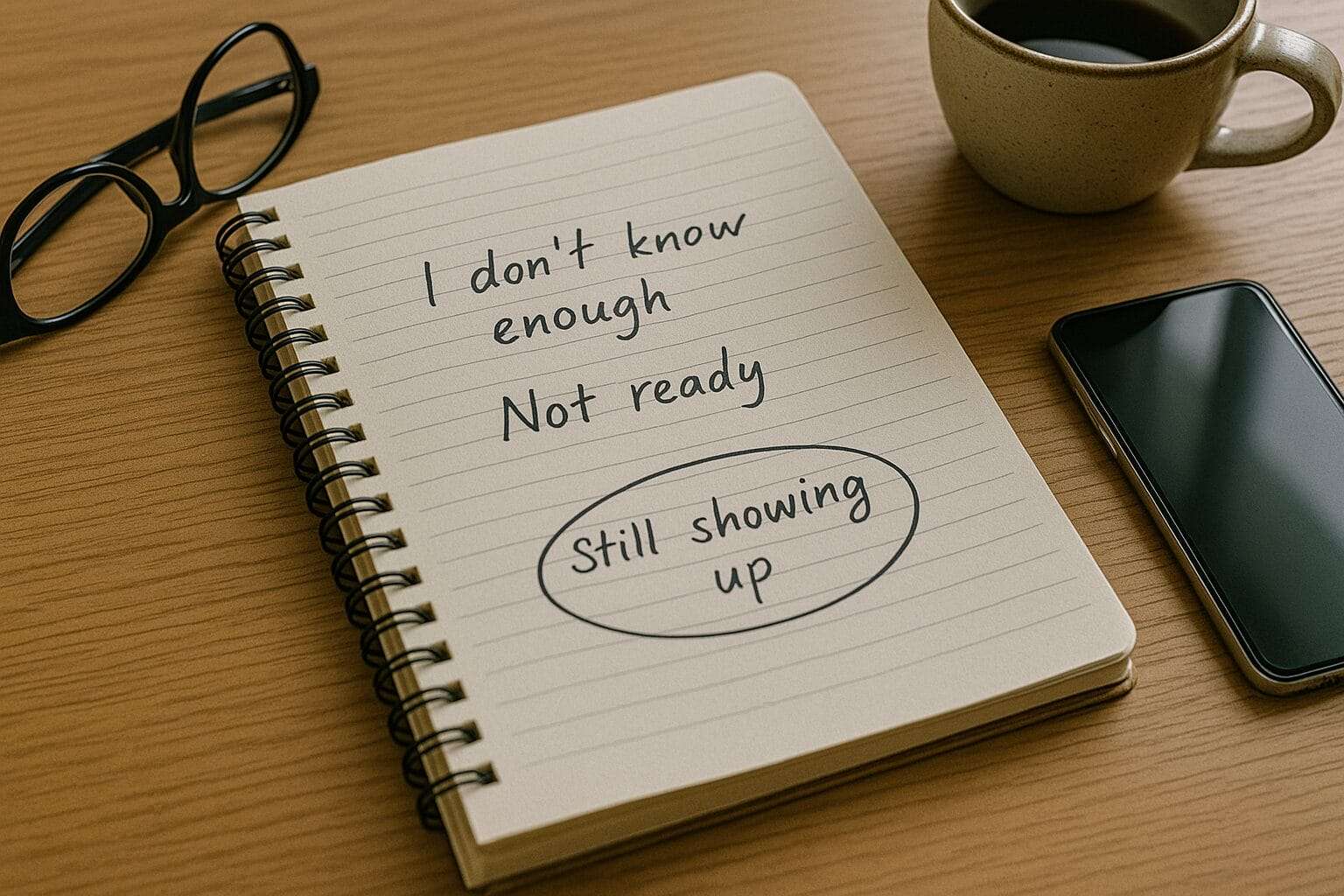
You’re Too Damn Capable to Keep Calling Yourself a Fraud: Why Imposter Syndrome Is a Trauma Echo—Not the Truth
- Updated: June 19, 2025
Let’s be honest.
You’ve got the receipts. The track record. The wins.
You’ve built things from nothing. You’ve rebuilt even after life knocked the wind out of you. You’ve outgrown whole versions of yourself—and entire industries—just to stand where you are.
And yet…
You’re still wondering if you’re a fluke.
Still bracing for someone to find out you’re not “legit” enough.
Still holding your breath when the praise rolls in—because deep down, you’re not sure you’ve earned it.
What the hell is that about?
Let me tell you.
You’re not broken. You’re not faking it.
You’re just living with an outdated emotional blueprint.
You’re still carrying echoes:
– Of that crusty old professor who gave you a C and a smirk.
– Of that boss from 15 years ago who said you “weren’t leadership material.”
– Of those Reddit trolls your assistant begged you not to read (but you did anyway).
– Of the silence from people you wanted to impress but never could.
And here’s the kicker: you know it’s crazy.
You know the logic doesn’t track—but your body still tenses.
Your mind still replays the doubt.
Because trauma doesn’t live in logic. It lives in memory.
Let’s put a stop to that.
This post is going to walk you through how imposter syndrome ties into trauma, how it tricks your brain, and how to start reclaiming your damn power—without needing another plaque, another testimonial, or another ounce of external validation.
Ready?
Let’s go.
Your Self-Trust Rebuild Starts Here
🧠 Why Imposter Syndrome Hits Leaders So Hard (Even When You “Know Better”)
Let’s get something straight.
This isn’t about intelligence. Or awareness. Or logic.
You could have all the degrees, accolades, and framed affirmations in the world—and still feel like a fraud the second someone compliments your work.
You’re not crazy.
You’re not ungrateful.
You’re just a human with a nervous system.

Here’s what most high-achievers don’t realize:
The smarter and more self-aware you are, the more susceptible you can be to imposter syndrome—especially if you’ve got unresolved trauma.
Why?
Because your brain isn’t built to be fair.
It’s built to protect you.
🧬 Neuroscience 101: Negativity bias is baked into your biology.
Your amygdala—the brain’s threat radar—reacts more intensely and quickly to negative information than to positive input.
Research shows your brain can detect potential threats in as little as 1/10th of a second—activating your fear response before reason even has a chance.
Meanwhile, positive experiences need to be held in conscious awareness for 12–20 seconds before they begin to reshape your neural pathways.
In other words:
Your brain is fast at fear and slow at self-trust.
Especially if your trauma taught you that success = exposure, leadership = abandonment, or being seen = risk.
This is why high performers often spiral in silence.
Because deep down, you don’t just doubt your skill—you doubt your safety.
Dr. Valerie Young, one of the leading experts on imposter syndrome, puts it this way:
“Imposter syndrome is a psychological pattern in which an individual doubts their accomplishments and has a persistent fear of being exposed as a fraud.”
And that fear? It’s not imagined.
It’s rooted in real past experiences that made visibility feel dangerous.
So even when your résumé screams “qualified,”
Your nervous system whispers, “Careful. They might come for you next.”
But here’s the truth:
This isn’t weakness. It’s patterning.
And patterns can be rewritten.
Someone asked me today, "How do I become more brave?"
— Denise G. Lee (@DeniseGLee) October 1, 2024
My answer: Care less about outcomes or reactions.
Too many of us are walking on eggshells, hoping and praying we don't offend the wrong people.
We think if we get approval from the RIGHT people, we’ll feel better about…
💣 Trauma Doesn’t Care How Long You’ve Been in the Game
If you thought imposter syndrome was just for the newbies—think again.
This isn’t a junior varsity problem.
This is a human nervous system problem.
And the more seasoned you are, the steeper the spiral can get.
Why?
Because the stakes are higher now.
You’re not launching a baby project with five followers anymore.
You’ve got eyes on you. Teams depending on you. Clients watching your every move. A reputation that took years—decades—to build.
So when doubt hits, it doesn’t feel cute.
It feels dangerous.
It’s not “Aw, I hope I’m good enough.”
It’s “If I mess this up, someone’s going to screenshot it, misquote me, twist the narrative, and I’ll be a cautionary tale in someone else’s LinkedIn post.”
That’s not paranoia.
That’s the reality of high visibility in a performative world.

And if you’ve got a trauma history? Multiply that pressure by ten.
Because trauma taught your body to expect rejection, abandonment, or punishment if you take up too much space—or get too comfortable.
So even now—after all your wins, your clients, your hard-earned wisdom—you still find yourself hesitating.
Second-guessing.
Shrinking just a little when it’s time to go bold.
Not because you’re weak.
But because your body remembers what it was like when it wasn’t safe to be seen.
And on some level, it still thinks that if you get too big, you’ll lose everything.
This is why imposter syndrome doesn’t disappear with experience.
It evolves.
It gets sneakier. More polished. More disguised as “professionalism” or “humility.”
But here’s the truth:
That fear isn’t your fault.
It’s the emotional residue of survival.
And you’re not crazy for feeling it.
You’re just ready to stop letting it run the show.
🧘🏾♀️ You Can’t Heal Your Mind If You Keep Abandoning Your Body
Let’s be clear:
This isn’t about lighting a candle, taking a salt bath, and calling it “self-care.”
This is about survival.
About reclaiming your nervous system from the grip of trauma responses disguised as productivity.
Because when you’re battling imposter syndrome, the first part of you to go offline is your body.
You stop sleeping.
You run on caffeine and adrenaline.
You operate like a floating head—pushing through, proving your worth, performing for imaginary critics.
And for what?
Let’s be real.
The people you think you’re trying to impress? They’re not even watching.
The people who doubted you? They’re not waiting to be proven wrong.
They’re waiting for you to fall apart—because brokenness validates their smallness.
And here’s the truth that’ll set you free:
You could sacrifice your peace, your rest, your joy—and they still wouldn’t be satisfied.
Because they don’t want your success.
They want your exhaustion.
They want your blood.
Your job?
Don’t give them a damn drop.

Dysregulated leaders don’t build sustainably.
Imposter syndrome thrives when you’re disconnected from your body.
Because your body is the only thing that can call B.S. on the fear loop.
🧠 Your mind says: “They’re going to find me out.”
🫀 Your body—when it’s grounded—says: “I’m safe. I’m here. I’m not shrinking.”
But you can’t access that grounded truth when you’re:
Skipping meals
Working through migraines
Sleeping 4 hours a night
Calling burnout ‘discipline’
Treating every workday like a warzone
This isn’t just a wellness issue.
It’s a leadership issue.
Because a dysregulated leader doesn’t build sustainably.
They build reactively, fearfully, and for the wrong audience.
So no—this isn’t about massages and mantras.
It’s about no longer offering your body as collateral for credibility.
Want to rewrite your imposter narrative?
Start by coming home to your body.
And then protect it like hell.
🧩 Practical Ways to Rewire the Doubt Without the Hype
No mantras.
No shouting in the mirror.
No “act as if” energy.
This isn’t about pretending you feel confident.
This is about building the emotional infrastructure that helps you lead from a place that’s actually stable.
Here are the tools I’ve used with clients—and myself—when the self-doubt script tries to sneak back in:

1. Name the Pattern, Don’t Merge With It
When the “I’m not enough” voice shows up, don’t argue with it—label it.
“Oh, that’s the survival voice again.”
“Oh, that’s my old fear of being visible.”
You’re not dismissing it. You’re just refusing to let it narrate your leadership.
2. Build a Receipts Folder (Not for Your Ego—for Your Nervous System)
Keep a file—digital or physical—of your wins. Client breakthroughs. Kind words. Things you’ve built.
It’s not about arrogance.
It’s about reminding your trauma-wired brain that you’ve done hard things and survived.
Proof calms panic.
3. Talk to Yourself Like You Talk to a Client
You’d never tell a client, “You probably are a fraud, actually.”
So why tolerate that tone in your own head?
Start speaking to yourself like someone you’re responsible for protecting. Because you are.
4. Stay Rooted in Process, Not Performance
The more you obsess over how something will be received, the more you distort it.
Ground yourself in process:
Did I show up with clarity?
Did I honor my truth?
Did I act in alignment—even if no one claps?
That’s how you build trust with yourself again.
5. Stop Worshiping “Results” That Come From Self-Betrayal
You can hit revenue goals, land the press, get the attention—and still feel hollow.
If your success came from abandoning your truth, your body will never feel safe enjoying it.
So ask:
“Am I proud of how I got here?”
If the answer is no, adjust your method. Not your worth.
6. Be Seen by People Who Can Actually Hold You
Some of your shame spirals are louder because you’re trying to be validated by people who don’t have the capacity—or the character—to reflect the truth back to you.
Don’t confuse high standards with unhealed projections.
Find spaces (therapy, coaching, trusted peers) that reflect back your reality—not your worst-case fears.
7. Let It Be a Practice, Not a Project
You’re not going to “solve” imposter syndrome in one journaling session.
This is lifelong work.
But it gets lighter when you stop expecting a final arrival point—and start building daily patterns of self-honoring.
❓FAQ: Still Wrestling With Doubt? You’re Not Alone—But You’re Not Stuck Either.
Even with all this clarity, imposter syndrome can still try to sneak in through the side door.
So let’s answer the quiet questions that tend to linger—even after a breakthrough.

Q: I still feel like a failure sometimes. Does that mean I haven’t healed?
Not at all. It means you’re human.
Failure isn’t evidence that you’re broken—it’s evidence that you’re in the arena.
What trauma teaches us is that failure = danger. Shame. Abandonment.
But real healing reframes that:
You didn’t fail. You learned in public.
You took a risk without a guarantee.
That’s leadership—not incompetence.
Q: I’m successful, but I still wait for someone to revoke it all. What’s that about?
That’s a trauma echo—the part of you that learned early on that good things don’t last, or that success has a price.
It’s the body saying, “This feels too safe to be real.”
But you don’t have to keep living by old scripts.
Try this:
👉 “Why Self-Trust Feels Impossible After Trauma—and How to Rebuild It”
Q: I know I’m not a fraud… but I still feel like one. How do I make that stop?
You don’t “make it stop.” You learn to recognize when it shows up—and what it’s trying to protect.
That’s the real shift.
Not deleting the doubt, but learning not to obey it.
Doubt doesn’t mean you’re unqualified.
It means you’ve grown beyond the container you were once forced to survive in.
Need help recognizing those patterns?
👉 “Life Scripts and Leadership: How Your Story Influences Your Style”
Q: How do I know if I’m healing—or just performing strength better?
Excellent question.
Healing feels like less urgency. Less overexplaining. Less need to prove.
It feels like:
Saying less, but meaning more
Being okay with silence, uncertainty, or not being “got”
Leading with presence, not performance
This might help:
👉 “The Dark Side of Stoicism: How Emotional Sobriety Makes You a Better Leader”
Q: What if I keep cycling through all of this? Doesn’t that mean I’m not fit to lead?
Nope.
It means you’re paying attention.
Real leaders don’t bypass doubt—they build the capacity to lead through it.
You’re not late. You’re not behind.
You’re just shedding a survival identity that no longer fits.
Want a reminder that your pain doesn’t disqualify you?
🪞 Final Thoughts: You’re Not a Fraud. You’re Just Unlearning What Fear Taught You.
If you take nothing else from this, take this:
You didn’t get lucky.
You got strong.
You didn’t stumble into success.
You crawled, rebuilt, and healed your way into it—whether anyone clapped for you or not.
Imposter syndrome isn’t proof that you’re broken.
It’s a flare from the past—a trauma echo that says, “Be small. Be careful. Don’t get hurt again.”
But you’re not there anymore.
And you don’t owe your past the lead role in your present.
The truth is: you’ve done the work. You’ve earned your voice.
And if it still feels shaky, that’s okay. Shaky doesn’t mean fake.
It means you’re doing it without armor.
If you’re tired of doing it all alone—of trying to outgrow self-doubt without support—I’d be honored to walk with you.
💛 Work with me, Denise G. Lee – Together, we’ll unpack the deeper patterns driving your imposter spiral and build clear, grounded confidence that doesn’t require proving, performing, or pleasing.
👉 Explore working together
🎙️ Want to keep unpacking this in your ears?
Check out the podcast for more unfiltered talk on trauma, self-trust, and emotional leadership.
👉 Introverted Entrepreneur – wherever you stream
💌 Got thoughts about this article?
I’d love to hear what landed—or what you’re still wrestling with.
👉 Send me a message
And just so you remember:
You’re not an imposter.
You’re a leader who’s been through the fire.
You’re allowed to trust your own strength now.





